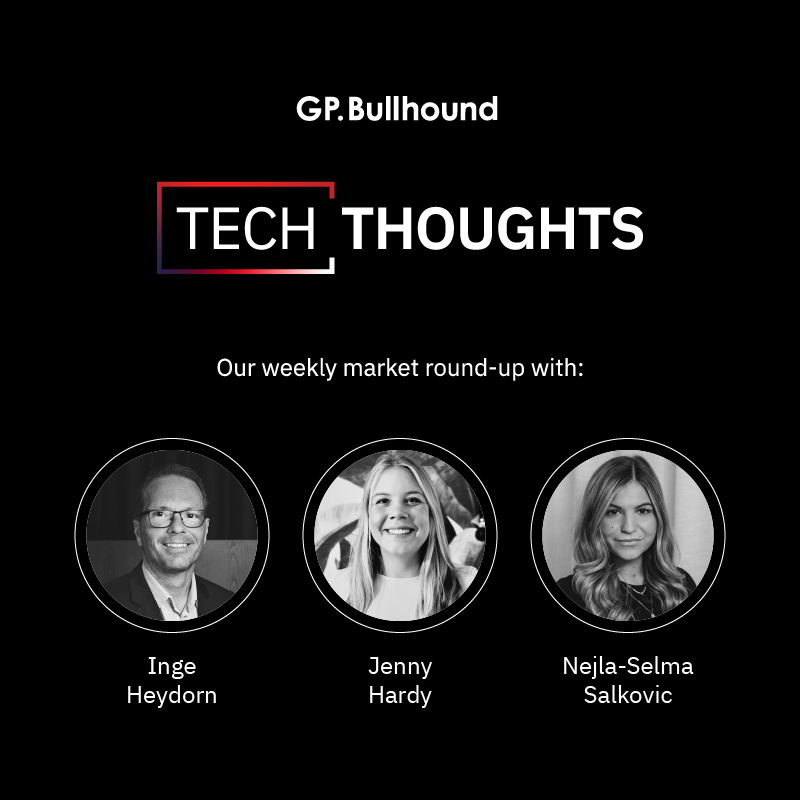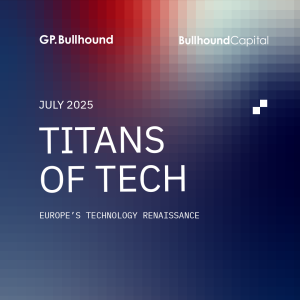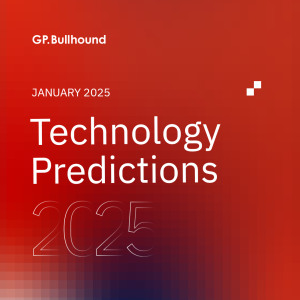Tech Thoughts Newsletter – 26 January 2024.

Market: We’re now firmly amid results season, which has been the primary driver of share prices this week. The market is still in broad “risk-on” mode, driving tech higher.
Portfolio: We added to LAM Research ahead of numbers this week following the strong ASML memory order book.
Semicap equipment – orders are back, memory AI demand picking up the baton?
- The standout results for us in the portfolio this week were ASML, where blowout orders sent shares up 10% on the day.
- A big swing factor this quarter has been around memory builds. Memory spend in 2023 was at unsustainably low levels, the reversal of which is now compounded by AI-related HBM memory demand.
- ASML (owned) orders came in at €9.2bn from €2.6bn last quarter. Importantly, that was driven by both logic and memory demand.
- We’ve spoken before about the semiconductor content increases moving from a traditional enterprise server to an AI server – the most significant increase is in GPU (which is the primary driver of Nvidia) but there is also a significant memory upgrade – 6-8x more DRAM content.
- HBM (High Bandwidth Memory – which is required in AI given higher processing speeds) die sizes are twice the size of equivalent capacity – that’s important because higher die sizes naturally limit industry supply growth, and ultimately need more semicap equipment.
- LAM Research (owned) is the most memory-exposed name, and we think it is already seeing significant benefits from HBM demand. It beat revenue and EPS and guided next quarter’s demand better.
- We’re also seeing pricing stabilise/recover more broadly for DRAM and that is an environment in which we typically see memory semicap spend start to increase.
- Relatedly, SK Hynix (not owned) results came in above consensus, with Q4 DRAM ASP’s up high teens qtr/qtr. It saw DDR5 sales increase more than 4x and HBM3 sales increase more than 5x vs 2022. It says it sees limited risk of oversupply in HBM and on the call noted the long lead times required to build supply – which will help with ongoing price stability.
- Looking at the shorter-term cyclicality, both ASML and LAM commented on signs of improving utilisation and an ending of the broad semis inventory correction.
- KLA (owned) also reported better revenue and EPS, though the guide was light – down 8% qtr/qtr – the call clarified that relates to one significant push out (we think Samsung’s Taylor fab)
- Overall, the view around the 2024 WFE market is for it to land in the mid to high $80bns – flat to slightly up on 2023, and for that to be second half weighted.
- For all of KLA, ASML and LAM Research, China is a big part of sales, and there is still the question mark around how sustainable that is, with that uncertainty compounded by the ongoing risk of increased export regulations. All spoke to resilient demand, LAM expecting it to remain stable in 2024 and ASML: “One thing is for sure, China will remain very strong in our numbers also in 2024.”
- We believe it makes a lot of sense for China to try to build up a strategic position in trailing edge semis and that they will continue to spend.
Portfolio view: We own LAM, KLA, ASML and Applied Materials in the semicap space, and view the sector as being supported by long-term demand drivers over the next 5-10 years. All have fundamental strong barriers to entry in the industries they serve (each has a dominant market share position in their specific process technology areas). And all have demonstrated returns resiliency amidst the current spend downturn.
Software demand holding up, AI as a revenue driver?
- ServiceNow (owned) beat Q4 and raised their FY24 guidance.
- The most important forward looking cRPO number came in +23% yr/yr, a 2% beat vs consensus, and they raised their FY24 subscription revenue guidance (given initially in May).
- Notably, that better top line comes with leverage: FY24 guided operating margin is going to 29% from 28%; Q4 operating margin came in at 29%, 150bps ahead of 27.5% guidance/consensus.
- The release and call were both full of references to AI features again (they announced that Now Assist – which comes with a 60% list price uplift – saw the largest net new ACV contribution for the first quarter of any new product family release).
- There’s likely much more upside than the guidance – particularly if new GenAI products continue to gain early traction on release.
- SAP reported solid results too, importantly cloud showing acceleration. It also announced restructuring and interestingly is now going to include share-based compensation expense within its reported results – it’s an interesting move in a sector where share-based compensation has so commonly been excluded in “adjusted” figures, despite it being a very real expense. In our analysis of our portfolio companies, we include share-based compensation as an expense item, which is much more representative of a business’s true profitability and valuation.
- Microsoft (owned) held its “AI Tour” in New York this week. The incremental news was that they will release GitHub Enterprise CoPilot at the end of February at a $39/month price point (higher than the current $19/month for the “business standard” product) – it will have additional features and use the latest GPT models.
- CEO Satya Nadella was on usual fine form for his keynote, talking about “breakthrough” productivity gains for developers using Github Copilot.
Portfolio view: ServiceNow and SAP give us a degree of reassurance in a stabilisation of enterprise software spend. In particular, they’re seeing the strength in the larger ACV deal volumes. We continue to think of AI as a driver of a reacceleration of revenues, either explicitly priced (a la Microsoft) or as a way to push through better than inflationary price increases (like we’ve seen at Salesforce).
Intel focus on foundry ambitions – good news for semicap
- Intel (not owned) beat the quarter on top and bottom lines. It all came from the client business and the stronger PC market, which we largely knew from the better notebook shipment data we’ve seen.
- However, the guidance was significantly below expectations, hurt by Mobileye (which we wrote about a couple of weeks ago – it being hurt by its own market share issues) and still ongoing weakness in the centre. The PC business is coming off a relatively better Q4 but both the PC and data centre business will be down low teens in the quarter – higher (or worse) than usual seasonality.
- Intel has been on a wild ride over the last 12 months – from the shocker Q1 guidance a year ago, then helped by the end of the PC inventory correction and caught up late last year in the AI hype. When the dust settles there’s no escaping it still struggling against AMD in CPU, and while there will be an edge/end device opportunity in AI, that will take longer to come through, and in the meantime they’re still being hurt by spend going away from general purpose compute towards AI – and that clearly is not going away any time soon.
- They do have a GPU alternative to Nvidia – Gaudi, but that will only ship $1bn in 2024 – a fraction of Nvidia/AMD – which shows just how far behind they are.
- Some interesting comments related to TSMC results last week (see also last week’s letter) – it sounds like Intel will continue to be a large part of TSMC’s long term 3nm thinking. That’s also important for ASML with the N3 build using ASML’s 3800 immersion tools (vs the prior 3600) which have a higher ASP (>€200m) – the shift to 3800 and the ASP increase was also called out in their results this week:
We do use external foundries and obviously that grew as we were dealing with some of our own challenges for process competitiveness. And as we create more and more focus in the business, more wafers will come in internal to the Intel factory network. But long-term, we’re going to continue to use external foundries to complement, manage our capital requirements. And to make sure that our teams always are building the best products in the industry and using the best technologies to accomplish that. So overall, we feel super good with our strategy. You’ll see more use of our own factory network, even as we leverage external foundries where appropriate.”
- Most interesting for us not owning Intel (and particularly for our ASML position) is that much of the call was focused on regaining manufacturing leadership and building its foundry business – lots more EUV machines likely coming in the order books. And gross capex (ie. before government subsidies/Brookfield contribution) will grow this year.
- Staying on AI chip news, the weekend saw numerous articles around Sam Altman (OpenAI) looking for funding around a chip venture – with some saying that he is already in talks with TSMC. That was followed with news that Sam was in Korea meeting Samsung yesterday/today.
Portfolio view: It’s way too early to build an investment thesis on Intel’s foundry business; it’s still losing share to AMD in datacentre; and there are competitive threats on the horizon in its core business.. BUT it’s clearly committed to spending and that’s good news for us with semicap. There is a long way to go (and lots of EUV machines to buy) for Intel to get anywhere near TSMC’s position in leading edge manufacturing – and indeed that’s clear with Intel seemingly having no real plans to end their foundry relationship with TSMC.
Auto semis mixed – Chinese players pressuring global OEMs?
- Texas Instruments and STMicro (neither owned) both reported this week. Both are exposed to the ongoing industrial weakness in semis and both are also exposed to auto – an important market for us.
- Their auto divisions showed more weakness than expected in Q4 (though not a disaster) and for Q1 both are expecting sequential declines in the low to mid teens.
- For STM, weakness specifically relates to an inventory correction in ADAS-related products – and, perhaps, a specific customer.
- Also in auto, Tesla clearly disappointed the market by not giving 2024 delivery guidance. We think lots of what we’re seeing in auto is China vs the rest of the world (including Tesla caution) – and a lot comes down to whether auto exposed semis are benefitting from the strength in the China EV market.
- We don’t own STMicro as we see it as more vulnerable to Chinese competition on their microcontroller product set, while for Infineon (which we own) we see their product set as having much more significant barriers to entry and therefore continuing to benefit from China power exposure.
Portfolio view: We own NXP and Infineon for the auto exposure, which we still see as (along with AI servers) the best area of structural semi content growth in the market.
Streaming, sports content and advertising
- Netflix (not owned) reported better subscribers in its results this week, as well as impressive profitability/FCF.
- Possibly famous last words on consolidation:
As our competitors adjust to these changes, it’s logical to expect further consolidation, particularly among companies with large and declining linear networks. We’re not interested in acquiring linear assets. Nor do we believe that further M&A among traditional entertainment companies will materially change the competitive environment given all the consolidation that has already happened over the last decade (Viacom/CBS, AT&T/Time Warner, Disney/Fox, Time Warner/Discovery, etc). But we expect our industry to remain highly competitive: the franchise strength and programming expertise within traditional entertainment companies; ongoing heavy investment from large tech players like YouTube, Amazon and Apple; and broader competition for people’s time, including gaming and social media (TikTok, Instagram etc.). It’s why continuing to improve our entertainment offering is so important, and as many of our competitors cut back on their content spend, we continue to invest in our slate. In FY24, we expect a high single-digit percentage year over year increase in content amortisation.”
- The other interesting news this week was Netflix acquiring WWE rights and Amazon investing in Diamond Sports. We’ve spoken before about the importance of sports as the last bastion content for the cable companies – as Netflix notes above the reality is that those cable companies are structurally challenged by high churn – and so will likely increasingly look to sell their sports rights.
- It’s also likely the case that Netflix’s ad strategy and sports goes hand in hand – we’ve said before that sports content monetised through advertising makes the most sense, so to the extent that Netflix is now going all in on its advertising tier, acquiring sports content makes sense.
Portfolio view: We’ve been sceptical about the long-term returns in streaming – the zero-interest-rate environments of the last several years led to an explosion of new streaming services and sky-high spending on content that was unsustainable, as well as the presence of the big tech players inflating content prices. Our only real exposure to streaming is through Sony, which is the perfect non-streaming streaming player, benefitting from the content inflation in its Pictures business without having to run a cash flow-negative streaming platform!
This set of results is another tick in the bull case – Netflix as the single powerful buyer in a world where all the content owners turn into arms dealers (and, perhaps ultimately, shut down their own returns, diluting streaming businesses).

For enquiries, please contact:
Inge Heydorn, Partner, at inge.heydorn@gpbullhound.com
Jenny Hardy, Portfolio Manager, at jenny.hardy@gpbullhound.com
Nejla-Selma Salkovic, Analyst, at nejla-selma.salkovic@gpbullhound.com
About GP Bullhound
GP Bullhound is a leading technology advisory and investment firm, providing transaction advice and capital to the world’s best entrepreneurs and founders. Founded in 1999 in London and Menlo Park, the firm today has 14 offices spanning Europe, the US and Asia.



